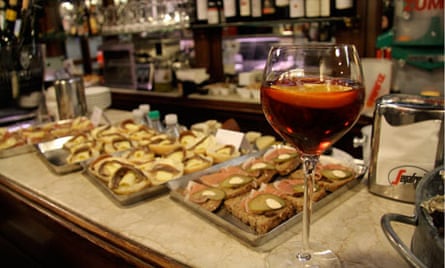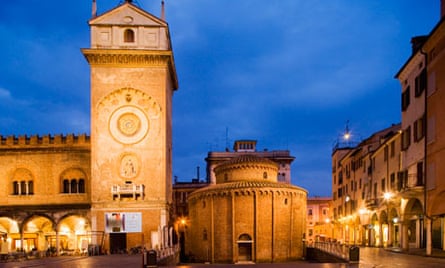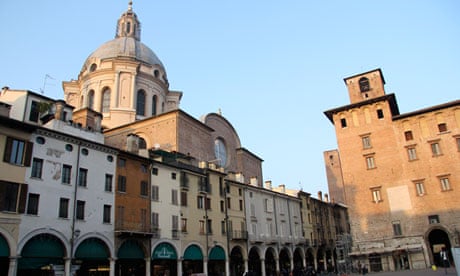I'm driving across the Ponte Legnano towards Mantua: the long bridge slices through two mist-covered lakes that form a gigantic moat protecting this majestic city. Suddenly, at the edge of the water, the swirling haze is broken by a dramatic skyline of ancient towers, turrets, cupolas and domes. Italian friends tell me that Mantua is known as La Bella Addormentata, a sleeping beauty that hasn't changed since the middle ages.
About 40km south of the popular destinations of Lake Garda and Verona, the city somehow gets bypassed by most travellers. The key to the puzzle is the lakes, a remarkable artificial fortification created nearly 1,000 years ago that effectively closed Mantua from the world. And these encircling wetlands mean the size of Mantua has scarcely altered – even today it takes only 20 minutes to walk across town. The place has been untouched by urban development, and even the present population of around 48,000 is pretty much the same as centuries ago. Italian ecology movement Legambiente voted Mantua as Italy's most livable city a few years ago, and I'm intrigued to find out what it is like to stay in a place where time seems to have stood still.
I check in at the elegant family-run Hotel Broletto in a 15th-century mansion – and only €75 for a double room. It is perfectly positioned, between Piazza delle Erbe, the old marketplace whose arched portico is lined with fashion boutiques and lively bars, and Piazza Sordello, a grandiose square with towering palaces and a striking white marble Baroque cathedral.

I decide to get the one must-see cultural sight out of the way, walking across cobbled Piazza Sordello to the Palazzo Ducale: it's no mere palace, rather a town within the city, the largest residence in Italy after the Vatican. For 400 years this was the home of the Gonzaga family, the dukes of Mantua who ruled until 1707, putting their stamp on everything, much as the Medicis did in Florence. The labyrinth includes a castle, basilica, courtyards, sumptuous galleries, gardens and more than 500 rooms. Fortunately, most of them are closed off, but there is still plenty to see, from precious tapestries, a glittering mirror-gallery and masterpieces by Raphael, to a zodiac painted as a psychedelic 16th-century ceiling fresco by Lorenzo Costa.
As the sun sets, it seems the town has set out on a passeggiata, the early-evening ritual of dressing in your finest and taking time for an Aperol spritz or an old-fashioned Americano. The mood changes from one bar to the next. A venerable 19th-century literary hangout, Bar Venezia on Piazza Marconi is packed with a chic pre-theatre crowd who look like eccentric extras from a Fellini movie, while funky Osteria Libenter on Piazza Concordia has a younger bohemian set who are being entertained by a jazzy DJ and poetry reading. But none compares to historic Bar Caravatti (Portici Broletto 16, +39 03763 21653), one of my top 10 European bars. All of Mantua passes through here, ordering the house aperitif, invented by Signor Caravatti in 1865, and still made from a secret recipe of wine and aromatic bitters.
The friendly barman, Max Orondini, says: "This place is like a slice of local life, from the lawyers and businessmen huddled over an espresso in the morning, to genteel ladies slipping in before the evening rush for a stiff Negroni, to the party crowd that turns up after midnight, when you'll discover that Mantua is not a museum city stuck in the middle ages." And as every bar competes to offer the most sumptuous complimentary buffet of pizzette, pasta, ham and cheeses, I don't even spend money on dinner in a restaurant.

What strikes me about Mantua is that there are no crowds of tourists or tacky souvenir stores, no long list of museums and churches to trudge around. I stumble upon a couple of hidden jewels by the hotel, with scarcely a visitor in sight: the intimate 11th-century Rotonda di San Lorenzo, inspired by Jerusalem's Holy Sepulchre church, and the fabulous rococo Teatro Bibiena, where the 13-year-old Mozart once performed.
Then it is time to concentrate on what the city is really famous for: its food. Elisabetta Arcari runs a cooking school (peccatidigola.info), where I take on Mantua's iconic product, the pumpkin, and make a total mess trying to make tortelli di zucca alla Mantovana. This being Mantua, the school is in a 14th-century palazzo – there are even frescoes in the loo. Arcari tells me: "Forget about the trendy restaurants here trying to reinterpret traditional Mantuan cuisine – it doesn't need it! Be adventurous and sample our specialities at the Osteria delle Quattro Tette [Vicolo Nazione 4, +39 03763 29478] and Trattoria Due Cavallini [Via Salnitro 5, +39 03763 22084]."
I can never resist this kind of challenge, and lunch at the no-frills Quattro Tette starts brilliantly. Everyone sits together on ancient wooden tables, there are no reservations, no credit cards and dishes cost €6-€10 each. They do a delicious luccio, pike in a tangy parsley and caper sauce, while the traditional risotto alla pilota is like no other I've tasted in Italy, not cooked and stirred with a brodo, but left to boil and mixed with a thick meat ragù, ending up more like a pilaf.
In the evening I have to decide if I am up for the classic Mantuan dish most locals are heartily tucking into at Due Cavallini. Stracotto d'asino is a rich stew, cooked for eight hours using, of all things, donkey meat. Dare I risk the wrath of Guardian readers – not to mention the website comments – and try donkey? I am an adventurous eater, and have sampled some strange dishes around the globe. And and the facts of life iIn France and Italy eating horse meat is no big deal. So, I decide to put my head in the noose and tuck in to the delicious dish. In many of the restaurants in the town centre, donkey has quietly been replaced by beef to avoid flare-ups with indignant tourists, but my waitress looks me sternly in the eye. "People from Mantua are proud of their cuisine and would never order stracotto of beef." Personally I reckon donkey and beef taste pretty much the same.
On the Sunday morning I do what most locals do and walk around the lakes, along with runners, dog walkers and pram-pushers, then stroll to the southern edge of the city, where the Gonzagas built a decadent pleasure palace in complete contrast to their austere Ducal palace.
Palazzo Te was conceived as a hideaway for 16th-century Duke Federico's trysts with his mistress. Created by one of the greatest Renaissance painters and architects, Giulio Romano, the palazzo has some of the most spectacular frescoes I have seen. The grotesque giants and monsters in the Sala dei Giganti are so stylised they could almost have inspired Marvel Comics, while the Bacchanalian scenes in the Cupid and Psyche room, where the duke held banquets, probably did inspire the occasional orgy.

Outside, I bump into a group of cyclists who tell me they are setting off later in the day on a giant barge moored on the lake. It's the first step of a week-long trip, organised by an innovative cycle tour company, (girolibero.it) to boat and bike all the way to Venice, where I live part of the year. I have definitely been seduced by Mantua's quiet charms, and this sounds the perfect way to return.

Comments (…)
Sign in or create your Guardian account to join the discussion